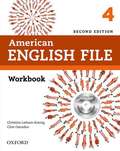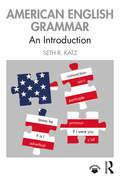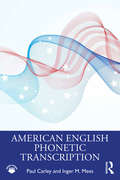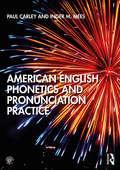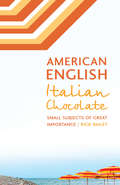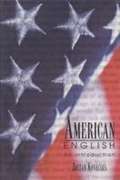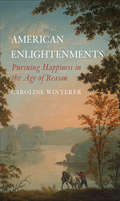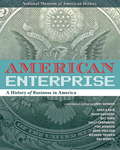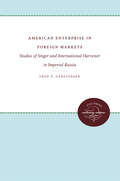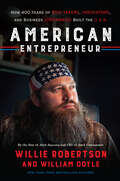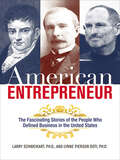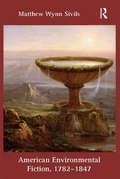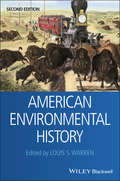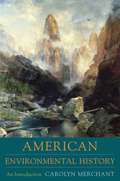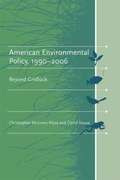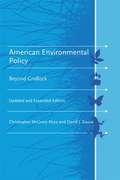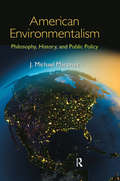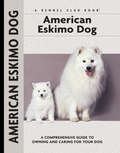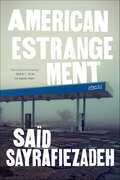- Table View
- List View
American English File With Online Practice: Level 4
by Christina Latham-Koenig Clive Oxenden Paul SeligsonFour-skills American English course with a communicative methodology, engaging texts, and a strong pronunciation syllabus - designed to get students speaking. With texts and topics that make learners want to speak, American English File is the course that gets students talking. It gives you full skills coverage with a clear focus on pronunciation, plus wide-ranging support and resources too. Resources include Test Generator CD-ROMs, DVDs, Multi-ROMs, and websites. The highly popular teacher's site has extra lesson ideas and resources for you to download.
American English File Workbook
by Christina Latham-Koenig Clive Oxenden Jane HudsonFour-skills American English course with a communicative methodology, engaging texts, and a strong pronunciation syllabus - designed to get students speaking. With texts and topics that make learners want to speak, American English File is the course that gets students talking. It gives you full skills coverage with a clear focus on pronunciation, plus wide-ranging support and resources too.
American English Grammar: An Introduction
by Seth R. KatzAmerican English Grammar introduces students to American English in detail, from parts of speech, phrases, and clauses to punctuation and explaining (and debunking) numerous "rules of correctness," integrating its discussion of Standard American grammar with thorough coverage of the past sixty years’ worth of work on African American English and other ethnic and regional non-Standard varieties. The book’s examples and exercises include 500 real-world sentences and longer texts, drawn from newspapers, film, song lyrics, and online media as well as from Mark Twain, Stephen King, academic texts, translations of the Bible, poetry, drama, children’s literature, and transcribed conversation and TV and radio shows. Based on twenty years of classroom testing and revision, American English Grammar will serve as a classroom text or reference that teaches students how to think and talk not only about the mechanics of sentences but also about the deep and detailed soul and nuance of the most widely used language in human history.
American English Phonetic Transcription
by Inger M. Mees Paul CarleyAmerican English Phonetic Transcription provides an accessible introduction to phonemic, phonetic, and intonational transcription with a focus on American English. Featuring exercises, revision tasks, and recordings to help students gain hands-on practice, the book takes a learning-by-doing approach and ensures students gain practice using each new symbol or concept introduced before moving on to the next. Consisting of three parts, the book covers: transcribing individual words, including consonants, vowels, primary stress, secondary stress, syllabic consonants, and inflections; transcribing phrases and sentences, including weak forms, elision, and assimilation; transcribing intonation, including the structure of English intonation and recognizing pitch patterns. Ideally suited as a standalone workbook or for use alongside British English Phonetic Transcription, American English Phonetic Transcription is key reading for undergraduate students of linguistics as well as anyone teaching or learning English as a foreign language.
American English Phonetics and Pronunciation Practice
by Paul Carley Inger MeesAmerican English Phonetics and Pronunciation Practice provides an accessible introduction to basic articulatory phonetics for students of American English. Built around an extensive collection of practice materials, this book teaches the pronunciation of modern standard American English to intermediate and advanced learners worldwide. This book: • provides an up-to-date description of the pronunciation of modern American English; • demonstrates the use of each English phoneme with a selection of high-frequency words, both alone and in context in sentences, idiomatic phrases and dialogues; • provides examples and practice material on commonly confused sounds, including illustrative pronunciation diagrams; • is supported by a companion website featuring complete audio recordings of practice material to check your pronunciation against; • can be used not only for studying pronunciation in the classroom but also for independent practice. American English Phonetics and Pronunciation Practice is essential reading for any student studying this topic.
American English, Italian Chocolate: Small Subjects of Great Importance
by Rick BaileyAmerican English, Italian Chocolate is a memoir in essays beginning in the American Midwest and ending in north central Italy. In sharply rendered vignettes, Rick Bailey reflects on donuts and ducks, horses and car crashes, outhouses and EKGs. He travels all night from Michigan to New Jersey to attend the funeral of a college friend. After a vertiginous climb, he staggers in clogs across the top of the Leaning Tower of Pisa. In a trattoria in the hills above the Adriatic, he ruminates on the history and glories of beans, from Pythagoras to Thoreau, from the Saginaw valley to the Province of Urbino. Bailey is a bumbling extra in a college production of Richard III. He is a college professor losing touch with a female student whose life is threatened by her husband. He is a father tasting samples of his daughter’s wedding cake. He is a son witnessing his aging parents’ decline. He is the husband of an Italian immigrant who takes him places he never imagined visiting, let alone making his own. At times humorous, at times bittersweet, Bailey’s ultimate subject is growing and knowing, finding the surprise and the sublime in the ordinary detail of daily life.
American English: An Introduction
by Zoltán Kövecses<P> This book is a cultural-historical (rather than purely linguistic) introduction to American English. The first part consists of a general account of variation in American English. It offers concise but comprehensive coverage of such topics as the history of American English; regional, social and ethnic variation; variation in style (including slang); and British and American differences. <P>The second part of the book puts forward an account of how American English has developed into a dominant variety of the English language. It focuses on the ways in which intellectual traditions such as puritanism and republicanism, in shaping the American world view, have also contributed to the distinctiveness of American English.
American English: Dialects and Variation (Language in Society #45)
by Natalie Schilling Walt WolframThe new edition of this classic text chronicles recent breakthrough developments in the field of American English, covering regional, ethnic, and gender-based differences. Now accompanied by a companion website with an extensive array of sound files, video clips, and other online materials to enhance and illustrate discussions in the text Features brand new chapters that cover the very latest topics, such as Levels of Dialect, Regional Varieties of English, Gender and Language Variation, The Application of Dialect Study, and Dialect Awareness: Extending Application, as well as new exercises with online answers Updated to contain dialect samples from a wider array of US regions Written for students taking courses in dialect studies, variationist sociolinguistics, and linguistic anthropology, and requires no pre-knowledge of linguistics Includes a glossary and extensive appendix of the pronunciation, grammatical, and lexical features of American English dialects
American Enlightenments: Pursuing Happiness in the Age of Reason
by Caroline WintererA provocative reassessment of the concept of an American golden age of European-born reason and intellectual curiosity in the years following the Revolutionary War The accepted myth of the "American Enlightenment" suggests that the rejection of monarchy and establishment of a new republic in the United States in the eighteenth century was the realization of utopian philosophies born in the intellectual salons of Europe and radiating outward to the New World. In this revelatory work, Stanford historian Caroline Winterer argues that a national mythology of a unitary, patriotic era of enlightenment in America was created during the Cold War to act as a shield against the threat of totalitarianism, and that Americans followed many paths toward political, religious, scientific, and artistic enlightenment in the 1700s that were influenced by European models in more complex ways than commonly thought. Winterer's book strips away our modern inventions of the American national past, exploring which of our ideas and ideals are truly rooted in the eighteenth century and which are inventions and mystifications of more recent times.
American Enterprise
by Nancy Davis Andy Serwer David Allison Peter Liebhold Kathleen G. FranzWhat does it mean to be an American? What are American ideas and values? American Enterprise, the companion book to a major exhibition at the Smithsonian's National Museum of American History, aims to answer these questions about the American experience through an exploration of its economic and commercial history. It argues that by looking at the intersection of capitalism and democracy, we can see where we as a nation have come from and where we might be going in the future.Richly illustrated with images of objects from the museum's collections, American Enterprise includes a 1794 dollar coin, Alexander Graham Bell's 1876 telephone, a brass cash register from Marshall Fields, Sam Walton's cap, and many other goods and services that have shaped American culture. Historical and contemporary advertisements are also featured, emphasizing the evolution of the relationship between producers and consumers over time. Interspersed in the historical narrative are essays from today's industry leaders--including Sheila Bair, Adam Davidson, Bill Ford, Sally Greenberg, Fisk Johnson, Hank Paulson, Richard Trumka, and Pat Woertz--that pose provocative questions about the state of contemporary American business and society. American Enterprise is a multi-faceted survey of the nation's business heritage and corresponding social effects that is fundamental to an understanding of the lives of the American people, the history of the United States, and the nation's role in global affairs.
American Enterprise in Foreign Markets: Studies of Singer and International Harvester in Imperial Russia
by Fred V. CarstensenIn 1914 the two largest firms in Russia were subsidiaries of American companies. Remarkably, they were almost as large as their parent companies, striking testimony to the potential of the underdeveloped Russian market. Fred Carstensen provides detailed histories of the movement of International Harvester and Singer into this new, profitable, and somewhat forbidding territory.Describing how both sales organizations evolved in Russia, Carstensen relates their development to overall company histories, worldwide growth, changing sales strategies and structures, recruitment and training of employees, and corporate leadership in America and abroad. He finds that both firms entered the Russian market because they needed new outlets to sustain high levels of production and sales. Although there are parallels in their experiences, Carstensen identifies how the responses of the two corporations differed, reflecting the varying strategies and perceptions of company management.Together the case studies provide a test for many of the supposed qualities and patterns of Russian economic history. Contrary to accounts of the experiences of other companies, these firms found the Russian market remarkably rich, developing a level of sales that might have surpassed the American market if war had not erupted. In contrast to the standard view of foreign enterprise, neither company came to Russia because of government invitation or influence but rather because of the intrinsic attractiveness of the markets, and neither firm found the government bureaucracy graft-ridden or the customers dishonest.Carstensen shows that International Harvester and Singer Sewing Machine clearly influenced Russia in a positive way. Both trained large numbers of Russians in modern industrial and marketing procedures and both provided an extraordinary volume of credit on comparatively easy terms to encourage purchase of their products. Indeed, the success of their approach suggests that Russian economic development may have been limited not by weak aggregate demand but by the relative absence of sources of credit.Originally published in 1984.A UNC Press Enduring Edition -- UNC Press Enduring Editions use the latest in digital technology to make available again books from our distinguished backlist that were previously out of print. These editions are published unaltered from the original, and are presented in affordable paperback formats, bringing readers both historical and cultural value.
American Entrepreneur: How 400 Years of Risk-Takers, Innovators, and Business Visionaries Built the U.S.A.
by William Doyle Willie RobertsonAmerica is the ultimate start-up venture – and these are the heroes who made it happenThe history of the United States is, to a remarkable degree, the story of its entrepreneurs, those daring movers and shakers who dreamed big and risked everything to build better lives for themselves and their fellow Americans. Drawing on his own family's remarkable journey, Duck Commander CEO and star of the blockbuster Duck Dynasty series Willie Robertson tells the captivating true tale of the visionaries and doers who have embodied the American dream.We begin with the first American entrepreneurs, the Native Americans, who established a highly sophisticated commercial network across the land in the precolonial days. The original Founding Father, George Washington, was also a founding entrepreneur, at the head of a thriving agribusiness venture that gave him the executive skills to steer the nation through the darkest hours of the American Revolution. Then, of course, there were the mega entrepreneurs, legendary figures like Astor, Vanderbilt, Carnegie, and Rockefeller, who transformed America, connected the country with miles of railroad track and supplied the fuel and steel that would help make America the most powerful nation on earth. And in recent years, business visionaries like Jobs, Gates, and Zuckerberg—not to mention the thousands of equally vital, yet smaller-scale, operators who spring up every year—have ushered America into the twenty-first century.American Entrepreneur also relates the story of the Robertson family business, telling how Willie’s family turned a humble regional duck call manufacturer, founded by his father, Phil, into an international powerhouse brand. From a young age, Willie had the entrepreneurial bug, buying candy in bulk and hawking it on the school bus. He did special orders and earned a small fortune for a ten-year-old—until he was hauled into the principal’s office and told to knock it off. So he transferred his focus to Phil’s fledgling business, helping in whatever way he could, from folding endless numbers of cardboard boxes to acting as the company’s customer service department—though he still wasn’t out of grade school. Willie helped build Duck Commander, which he now runs, into a worldwide brand, culminating in the mega success of the Duck Dynasty television show.American Entrepreneur tells a most American tale, of those among us who, through their vision, ingenuity, and good old-fashioned hard work, made something that changed the world.
American Entrepreneur: The Fascinating Stories of the People Who Defined Business in the United States
by Larry Schweikart Lynne Pierson DotiThis book vividly illustrates the history of business in the United States from the point of view of the enterprising men and women who made it happen.Ever since the first colonists landed in the New World, Americans have forged ahead in their quest to make good on promises of capitalism and independence. Weaving stirring narrative with economic analysis, this historical deep dive recounts the successes and failures of some of the most iconic business people to grace our history books--from the founding of our country to the present day.In American Entrepreneur, you&’ll learn about how:Eli Whitney changed the shape of the American business landscape;the Civil War impacted the economy, and how it was renewed by the subsequent dominance of Andrew Carnegie and J. P. Morgan;Asa Candler, W. K. Kellogg, Henry Ford, and J.C. Penney led the rise of the consumer marketplace;and Warren Buffett&’s, Michael Milken&’s, and Martha Stewart&’s experience in the &“New Economy&” in the 1990s--and how that economy continues today.It is an adventure to start a business, and the greatest risk takers in that adventure are entrepreneurs. This is the epic story of America&’s entrepreneurs and how they created the economy we enjoy today.
American Environmental Fiction, 1782-1847
by Matthew Wynn SivilsWhile Ralph Waldo Emerson and Henry David Thoreau are often credited with inventing American environmental writing, Matthew Wynn Sivils argues that the works of these Transcendentalists must be placed within a larger literary tradition that has its origins in early Republic natural histories, Indian captivity narratives, Gothic novels, and juvenile literature. Authors such as William Bartram, Ann Eliza Bleecker, and Samuel Griswold Goodrich, to name just a few, enabled the development of a credibly American brand of proto-environmental fiction. Sivils argues that these seeds of environmental literature would come to fruition in James Fenimore Cooper’s The Pioneers, which he argues is the first uniquely environmental American novel. He then connects the biogeographical politics of Cooper’s The Prairie with European anti-Americanism; and concludes this study by examining how James Kirke Paulding, Thomas Cole, and James Fenimore Cooper imaginatively addressed the problem of human culpability and nationalistic cohesiveness in the face of natural disasters. With their focus on the character and implications of the imagined American landscape, these key works of early environmental thought contributed to the growing influence of the natural environment on the identity of the fledgling nation decades before the influences of Emerson's Nature and Thoreau's Walden.
American Environmental History (Wiley Blackwell Readers in American Social and Cultural History)
by Louis S. WarrenExplore how the peoples of America understood and changed their natural environments, remaking their politics, culture, and societies In this newly revised Second Edition of American Environmental History, celebrated environmental historian and author Louis S. Warren provides readers with insightful examination of how different American peoples created and reacted to environmental change and threats from the era before Columbus to the COVID-19 pandemic. You'll find concise editorial introductions to each chapter and interpretive interventions throughout this meticulous collection of essays and historical documents. This book covers topics as varied as Native American relations with nature, colonial invasions, American slavery, market expansion and species destruction, urbanization, Progressive and New Deal conservation, national parks, the environmental impact of consumer appetites, environmentalism and the backlash against it, environmental justice, and climate change. This new edition includes twice as many primary documents as the First Edition, along with findings from related fields such as Native American history, African American history, geography, and environmental justice. Ideal for students and researchers studying American environmental history and for those seeking historical perspectives on contemporary environmental challenges, this book will earn a place in the libraries of anyone with an interest in American history and the impact of American peoples on the environment and the world around them. Louis S. Warren is the W. Turrentine Jackson Professor of Western U.S. History at the University of California, Davis. He is a two-time winner of the Caughey Western History Association Prize, a Guggenheim Fellow, and recipient of the Albert Beveridge Award of the American Historical Association and the Bancroft Prize in American History.
American Environmental History: An Introduction (Columbia Guides to American History and Cultures)
by Carolyn MerchantBy studying the many ways diverse peoples have changed, shaped, and conserved the natural world over time, environmental historians provide insight into humanity's unique relationship with nature and, more importantly, are better able to understand the origins of our current environmental crisis. <P><P>Beginning with the precolonial land-use practice of Native Americans and concluding with our twenty-first century concerns over our global ecological crisis, American Environmental History addresses contentious issues such as the preservation of the wilderness, the expulsion of native peoples from national parks, and population growth, and considers the formative forces of gender, race, and class. Entries address a range of topics, from the impact of rice cultivation, slavery, and the growth of the automobile suburb to the effects of the Russian sea otter trade, Columbia River salmon fisheries, the environmental justice movement, and globalization. This illustrated reference is an essential companion for students interested in the ongoing transformation of the American landscape and the conflicts over its resources and conservation. It makes rich use of the tools and resources (climatic and geological data, court records, archaeological digs, and the writings of naturalists) that environmental historians rely on to conduct their research. The volume also includes a compendium of significant people, concepts, events, agencies, and legislation, and an extensive bibliography of critical films, books, and Web sites.
American Environmental Policy, 1990-2006: Beyond Gridlock
by Christopher Mcgrory Klyza David J. SousaThe "golden era" of American environmental law making, between 1964 and 1980, saw twenty-two pieces of major environmental legislation passed by bipartisan majorities in Congress and signed into law by presidents of both parties.
American Environmental Policy, updated and expanded edition: Beyond Gridlock (American and Comparative Environmental Policy)
by Christopher Mcgrory Klyza David J. SousaAn updated investigation of alternate pathways for American environmental policymaking made necessary by legislative gridlock. The “golden era” of American environmental lawmaking in the 1960s and 1970s saw twenty-two pieces of major environmental legislation (including the Clean Air Act, the Clean Water Act, and the Endangered Species Act) passed by bipartisan majorities in Congress and signed into law by presidents of both parties. But since then partisanship, the dramatic movement of Republicans to the right, and political brinksmanship have led to legislative gridlock on environmental issues. In this book, Christopher Klyza and David Sousa argue that the longstanding legislative stalemate at the national level has forced environmental policymaking onto other pathways.Klyza and Sousa identify and analyze five alternative policy paths, which they illustrate with case studies from 1990 to the present: “appropriations politics” in Congress; executive authority; the role of the courts; “next-generation” collaborative experiments; and policymaking at the state and local levels. This updated edition features a new chapter discussing environmental policy developments from 2006 to 2012, including intensifying partisanship on the environment, the failure of Congress to pass climate legislation, the ramifications of Massachusetts v. EPA, and other Obama administration executive actions (some of which have reversed Bush administration executive actions). Yet, they argue, despite legislative gridlock, the legacy of 1960s and 1970s policies has created an enduring “green state” rooted in statutes, bureaucratic routines, and public expectations.
American Environmental Policy: Beyond Gridlock (Updated and Expanded Edition)
by Christopher Mcgrory Klyza David J. SousaThe "golden era" of American environmental lawmaking in the 1960s and 1970s saw twenty-two pieces of major environmental legislation (including the Clean Air Act, the Clean Water Act, and the Endangered Species Act) passed by bipartisan majorities in Congress and signed into law by presidents of both parties. But since then partisanship, the dramatic movement of Republicans to the right, and political brinksmanship have led to legislative gridlock on environmental issues. In this book, Christopher Klyza and David Sousa argue that the longstanding legislative stalemate at the national level has forced environmental policymaking onto other pathways. Klyza and Sousa identify and analyze five alternative policy paths, which they illustrate with case studies from 1990 to the present: "appropriations politics" in Congress; executive authority; the role of the courts; "next-generation" collaborative experiments; and policymaking at the state and local levels. This updated edition features a new chapter discussing environmental policy developments from 2006 to 2012, including intensifying partisanship on the environment, the failure of Congress to pass climate legislation, the ramifications of Massachusetts v. EPA, and other Obama administration executive actions (some of which have reversed Bush administration executive actions). Yet, they argue, despite legislative gridlock, the legacy of 1960s and 1970s policies has created an enduring "green state" rooted in statutes, bureaucratic routines, and public expectations.
American Environmentalism: Philosophy, History, and Public Policy
by J. Michael MartinezProtecting the natural environment and promoting sustainability have become important objectives, but achieving such goals presents myriad challenges for even the most committed environmentalist. American Environmentalism: Philosophy, History, and Public Policy examines whether competing interests can be reconciled while developing consistent, cohe
American Environmentalism: The US Environmental Movement, 1970-1990
by Riley E. Dunlap Angela G. MertigFirst published in 1992. Routledge is an imprint of Taylor & Francis, an informa company.
American Epic: The First Time America Heard Itself
by Elijah Wald Allison Mcgourty Bernard MacmahonThe companion book to the groundbreaking PBS and BBC documentary series celebrating the pioneers and artists of American roots music—blues, gospel, folk, Cajun, Appalachian, Hawaiian, Native American—without which there would be no jazz, rock, country R&B, or hip hop today.Jack White, T. Bone Burnett, and Robert Redford have teamed up to executive produce American Epic, a historical music project exploring the pivotal recording journeys of the early twentieth century, which for the first time captured the breadth of American music and made it available to the world. It was, in a very real way, the first time America truly heard herself. In the 1920s and 1930s, as radio took over the pop music business, record companies were forced to leave their studios in major cities in search of new styles and markets. Ranging the mountains, prairies, rural villages, and urban ghettos of America, they discovered a wealth of unexpected talent—farmers, laborers, and ethnic minorities playing styles that blended the intertwining strands of Europe, Africa, Asia, and the Americas. These recordings form the bedrock for modern music as we know it, but during the Depression many record companies went out of business and more than ninety percent of the fragile 78 rpm discs were destroyed. Fortunately, thanks to the continuing efforts of cultural detectives and record devotees, the stories of America’s earliest musicians can finally be told. Bernard MacMahon and Allison McGourty, who directed and produced the documentary with American musician Duke Erikson, spent years traveling around the US in search of recollections of those musical pioneers. Their fascinating account, written with the assistance of prize-winning author Elijah Wald, continues the journey of the series and features additional stories, never-before-seen photographs, and unearthed artwork. It also contains contributions from many of the musicians who participated including Taj Mahal, Nas, Willie Nelson, and Steve Martin, plus a behind-the-scenes look at the incredible journey across America. American Epic is an extraordinary testament to our country’s musical roots, the transformation of our culture, and the artists who gave us modern popular music.
American Eskimo Dog
by Richard G. BeauchampThe magnificent snow-white coated American Eskimo Dog is the focus of this Comprehensive Owner's Guide, a book that celebrates the appealing personality, unmistakable intelligence, and captivating beauty of this made-in-America spitz breed. Serving as a complete introduction to the breed, long recognized by the United Kennel Club and more recently by the American Kennel Club, this book discusses the breed's evolution in the United States, the special characteristics of the breed, and both the AKC and UKC breed standards.New owners will welcome the well-prepared chapter on finding a breeder and selecting a healthy, sound puppy. Chapters on puppy-proofing the home and yard, purchasing the right supplies for the puppy as well as house-training, feeding, and grooming are illustrated with handsome adults and puppies bursting with attitude and personality! In all, there are over 135 photographs in this compact, useful, and reliable volume. The author's advice on obedience training the smart (but not too eager to please) American Eskimo will help readers better mold and train their dogs into the most socialized, well-mannered Eskie in the neighborhood. The extensive chapter on healthcare provides up-to-date detailed information on selecting a qualified veterinarian, vaccinations, parasites, infectious diseases, and more. Chapters on showing and participating in dog sports as well as solving common behavior issues (such as barking, aggression, digging, etc.) will prove informative and helpful to the new owner. Sidebars throughout the text offer helpful hints, covering topics as diverse as historical kennels, toxic plants, first aid, crate training, carsickness, fussy eaters, and parasite control. Fully indexed.
American Estrangement: Stories
by Saïd SayrafiezadehFinalist for the 2022 Los Angeles Times Book Prize in Fiction Longlisted for the 2022 Story Prize A New York Times Editors' Choice pick One of Literary Hub's Most Anticipated Books of 2021 Stories that capture our times by “a young author who has already established himself as a unique American voice” (Elle).Saïd Sayrafiezadeh has been hailed by Philip Gourevitch as "a masterful storyteller working from deep in the American grain." His new collection of stories—some of which have appeared in The New Yorker, the Paris Review, and the Best American Short Stories—is set in a contemporary America full of the kind of emotionally bruised characters familiar to readers of Denis Johnson and George Saunders. These are people contending with internal struggles—a son’s fractured relationship with his father, the death of a mother, the loss of a job, drug addiction—even as they are battered by larger, often invisible, economic, political, and racial forces of American society.Searing, intimate, often slyly funny, and always marked by a deep imaginative sympathy, American Estrangement is a testament to our addled times. It will cement Sayrafiezadeh’s reputation as one of the essential twenty-first-century American writers.
American Ethnicity: The Dynamics and Consequences of Discrimination (5th Edition)
by Jonathan H. Turner Adalberto Aguirre Jr.This text introduces the dynamics of racial and ethnic relations.

